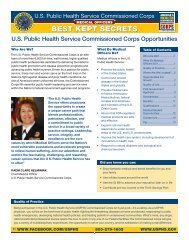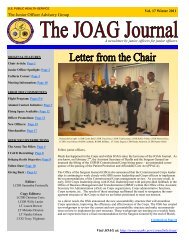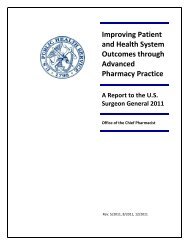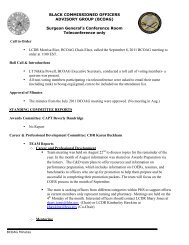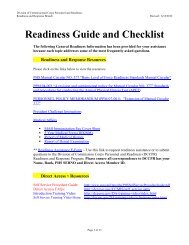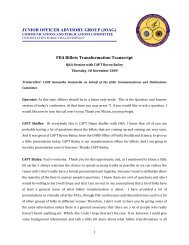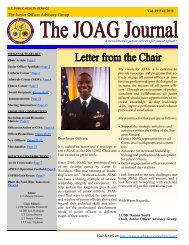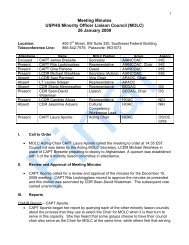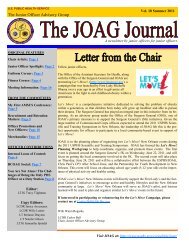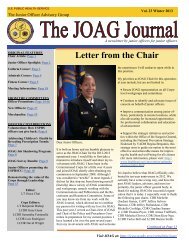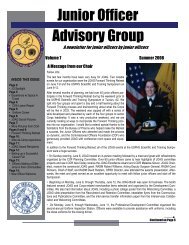December 2009 (G) - U.S. Public Health Service Commissioned Corps
December 2009 (G) - U.S. Public Health Service Commissioned Corps
December 2009 (G) - U.S. Public Health Service Commissioned Corps
Create successful ePaper yourself
Turn your PDF publications into a flip-book with our unique Google optimized e-Paper software.
nurse officers from the USPHS, US Army, US Air Force, and the US Navy were present.I was selected to attend under sponsorship of the Indian <strong>Health</strong> <strong>Service</strong> and encourage allnursing category PHS officers to apply for participation in the conference in the future.Working and learning alongside fellow officers of the PHS as well as 3 other branches ofthe uniformed services was a valuable experience which provided an opportunity not onlyto be mentored but to network with colleagues both within PHS and in other uniformedservice branches.• Readiness & Preparedness• The nursing category of the USPHS reached a readiness level of 95.2% in September of<strong>2009</strong>; however, a rapid and steep decline in this measure has occurred since. As of12/03/<strong>2009</strong>, basic readiness in the nursing category had dropped to a low point of 80.9%.It is thought that this number does not truly reflect the actual percentage of nurse officerswho are basic ready. NPAC members discussed how the transition to Direct Access maynot have been done correctly by each officer and this could result in the officer beingmeasured for readiness incorrectly if not all of the officer’s current data has beentransferred. Omission of certain items such as the APFT or vaccination records willcause an officer’s readiness status to change from READY to NOT READY. NPACleaders are researching if and how the transition to Direct Access has adversely impactedthe measurement of readiness among PHS nurses.• NOTE: The NPAC will not have a meeting in <strong>December</strong> of <strong>2009</strong>. Instead, the NPAC has anannual “retreat” in <strong>December</strong> of each year which is held in the Washington DC metro area.Unfortunately, remotely detailed officers are often not able to attend due to lack of sponsorshipfunds to pay for the travel and per diem that would be necessary for such an endeavor.Pharmacy Category: LCDR Yvette Waples• No updatesPhysician Category: LCDR Rajal Mody• CPO CAPT Helminiak is beginning recruitment and retention activities and wants to addressAgency needs such as the need for researchers at the NIH and to balance this Agency need withPHS needs for deployment, for example skills in medical trials might be useful in thedevelopment of vaccines or in assessments of product safety.• The new PPAC website should be operational soon. The communications subcommittee has beenworking to achieve the transition from the previous website which was through the NIH server.The Portal will serve as access to minutes, attendance, announcements, and committeeinformation. Information on Portal access will be updated.• The physician pilot program that has been ongoing for one year now. 9 officers have beenbrought on to date, 2 of whom are inter-service transfers and 7 who are senior civilian physiciansbrought on at the 05 rank. There are 20 pending applications.• Readiness Committee needs more members• All new PHS medical officers will be paired with a mentor.• The Retention committee is working to try to set up exit surveys that might be helpful foridentification of retention issues. The survey will be beta-tested and then will go for focus groupfacilitation.• The next open forum call will be Wednesday, <strong>December</strong> 16 th at 1pm.Scientist Category: LCDR Robin Toblin• Focus on how multidisciplinary billets will affect Scientist officers in the billet transformation -Leadership panel as part of Scientist Category Day at COF Symposium



